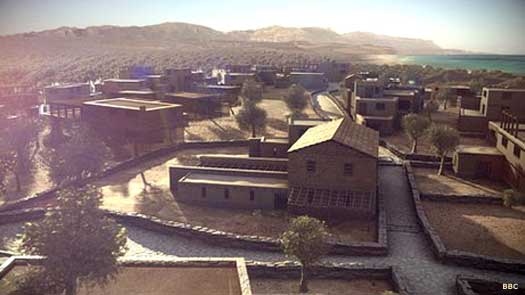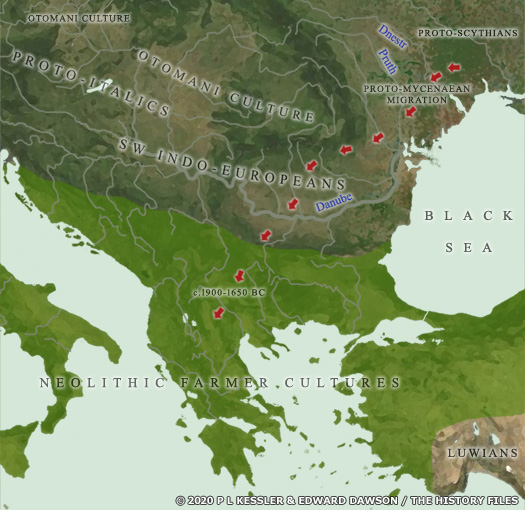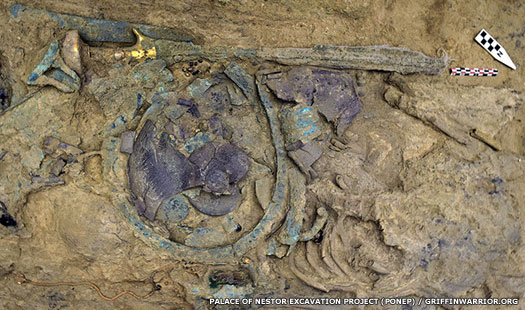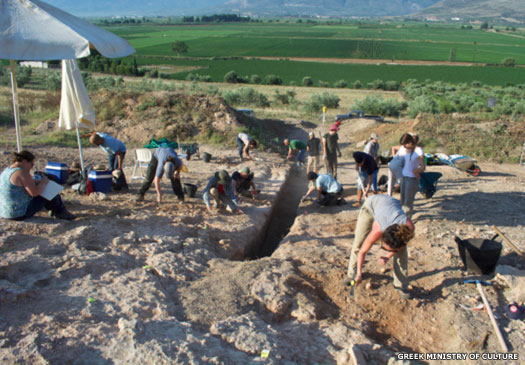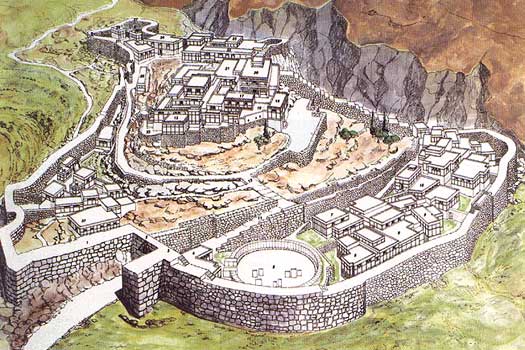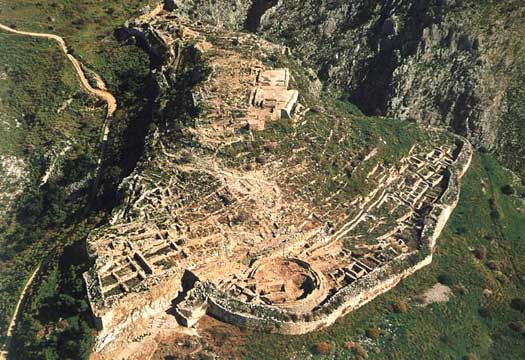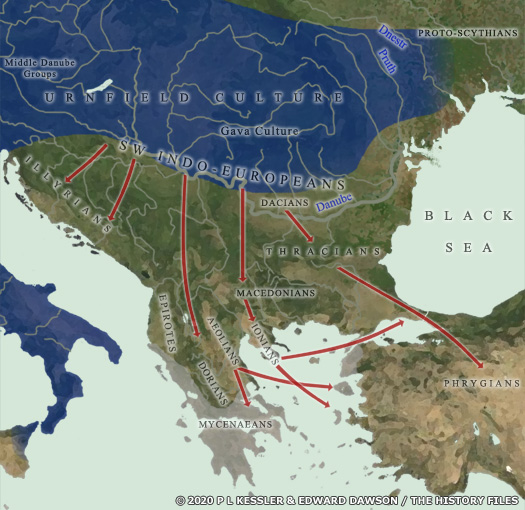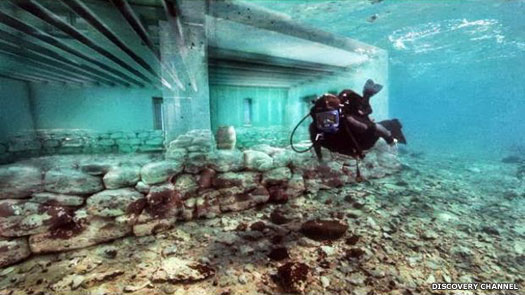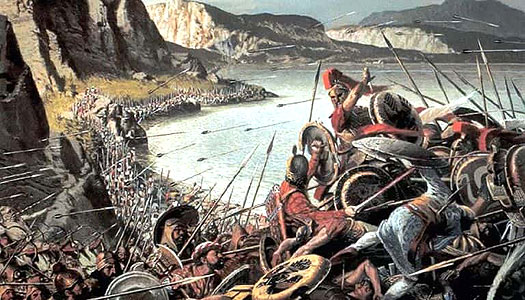
| MYCENAEANS The Mycenaeans were South-West Indo-Europeans, part of a much greater expansion and migration of Indo-Europeans from the northern shores of the Black Sea and Caspian Sea. In the twentieth century AD, a general consensus of scholarly opinion was that Indo-Europeans migrated into Eastern Europe from the Pontic-Caspian steppe in the period between 3300-2600 BC. After having left the main westwards migration of Indo-Europeans around 2500 BC, the ancestors of the Mycenaeans gradually blended into the indigenous population in the lower Balkans (largely, it seems, in the form of the Pelasgians) between then and 2000 BC. However, in recent years that idea has undergone some refinement.
Clearly the Mycenaeans were part of an imported steppe culture. But the close relationship between Mycenaean and proto-Indo-Iranian languages shows that these two branches divided fairly late, sometime between 2500-2000 BC. Archaeologically, Mycenaean chariots, spearheads, daggers and other bronze objects show striking similarities to the Seima-Turbino culture (between about 1900-1600 BC) of the northern Russian forest-steppe, known for the great mobility of its nomadic warriors (Seima-Turbino sites have been found as far away as Mongolia).
It is therefore likely that the Mycenaeans descended from the steppe into Greece between 1900-1650 BC, seemingly halting only briefly - if at all - amongst their Indo-European cousins along the Danube (the lack of dilution of their Indo-Iranian links precludes long-term integration with older western Indo-European groups with far lower levels of Indo-Iranian influence). Once in Greece they intermingled with and dominated the locals to create a new, unique Greek culture. Naturally, as the new dominant force in the region, their language would also have dominated. Those locals had gained between 62% and 86% of their DNA from people who had introduced farming from Anatolia as part of the Neolithic cultures of 'Old Europe'. They would have adopted this language fairly quickly or, if not them, then their children or grandchildren would have, which is why modern Greek expresses its Indo-European origins so clearly. However, the Indo-European influence on DNA in Greece was more subtle than across much of Europe, showing that these Mycenaean Indo-Europeans arriving in Greece were fewer in number than some of their cousins - a warrior elite imposing its language and customs on a numerically greater native population.
The new proto-Greek speakers covered a swathe of territory that reached as far north as Epirus and Thrace. They emerged into the archaeological record rather suddenly, with the appearance of shaft grave royal burials around 1650 BC. Whilst the first city states had emerged by 1600 BC (the same time at which Mycenaean culture also appears on Cyprus), the Mycenaeans did not form a single nation state. Instead they banded their independent city states together under one leader in times of trouble. During their own time they were known primarily as Achaeans, after the Achaea region of Greece.
Records on the Mycenaeans are very sparse, usually being limited to myths and legends. Many of their leaders are semi or wholly legendary. The latter are backed in lilac, usually for events prior to the Trojan War which itself is barely historical. Mycenaeans also established trading outposts on the Anatolian coast, and were possibly the Ahhiyawa mentioned in Hittite texts from the mid-fifteenth century onwards. Their civilisation seems to have flourished immediately following the fall of Minoan Crete, which seems to have dominated them up to that point. DNA research has shown that the Minoans of Crete were generally of the same origins as the Mycenaeans - Neolithic natives overlaid with an Indo-European cultural identity, and both share their DNA with today's Greeks.
(Information by Peter Kessler and Edward Dawson, with additional information from The Horse, the Wheel, and Language: How Bronze-Age Riders from the Eurasian Steppes Shaped the Modern World, David W Anthony, from The Iliad, Homer (Translated by E V Rieu, Penguin Books, 1963), from Europe Before History, Kristian Kristiansen, from A Dictionary of Greek and Roman Biography and Mythology, William Smith (Ed), from An Historical Geography of Europe, Norman J G Pounds (Abridged Version), from History of Humanity - Scientific and Cultural Development: From the Third Millennium to the Seventh Century BC (Vol II), Ahmad Hasan Dani, Jean-Pierre Mohen, J L Lorenzo, & V M Masson (Unesco 1996), and from External Links: Haplogroup R1a (Eupedia Genetics), and DNA clue to origins of early Greek civilization (BBC News), and Grave of the Griffin Warrior, and The Greeks really do have near-mythical origins, ancient DNA reveals (Science).)
c.3000 - 2800 BC :
The city of Pavlopetri is founded on the south-eastern coastal tip of the Peloponnese, in southern Laconia. Pavlopetri's inhabitants later copy Cretan and mainland styles, making exact ceramic copies of high status Cretan bronze jugs, in effect making cheap copies of expensive exotic goods in much the same way that desirable designer brands are copied today.
But the early city is neither a Minoan colony or a Mycenaean settlement - it predates both peoples in the area (and certainly the Mycenaeans), making it more likely to be a Pelasgian settlement that is later absorbed by the Mycenaeans and is subject to heavy Minoan influence or control in the second millennium BC. The city flourishes, reaching a peak around 2000 BC.
Modern computer graphics show a reconstructed Pavlopetri based on surviving ruins and remnants of the street plan, all of which still exist about three metres under the sea c.2600 BC :
This is a tentative dating for the earliest members of Greek mythology where it relates to kings of the Mycenaeans. Pandion II is the mythical ruler of Athens and father to Lycus of Lycia and Aegeus of Athens. Given the links between Aegeus and Medea, Pandion (if he exists at all) is more likely to be a thirteenth century BC king who is mistaken for an earlier king or whose dating is incorrect. The Mycenaeans of this time are still steppe nomads.
c.2000 BC :
Now at its height, the city of Pavlopetri contains detached and semi-detached two-storey houses with gardens, clothes drying in the courtyards, walls, and well-made streets. There are larger, apparently public buildings and evidence of a complex water management system involving channels and guttering. The city is divided into pleasant courtyards and open areas where people cultivate gardens, ground grain, dry clothes, and probably even chat with their neighbours. Dotted between the buildings and sometimes built into the walls themselves are stone-lined graves. These contrast with an organised cemetery just outside the city.
This is not a village of Neolithic farmers but a stratified society in which people have professions - city leaders, officials, scribes, merchants, traders, craftsmen (potters, bronze workers, artists), soldiers, sailors, farmers, shepherds and also probably slaves - all echoing the early hierarchical and organised aspects of Bronze Age Greece. Pavlopetri is now heavily influenced by the regionally-dominant Minoan culture.
c.1900 - 1650 BC : Now having left the steppe and arriving on the west bank of the River Prut (generally speaking, the modern border between Romania and Moldova), the proto-Mycenaeans likely meet other, closely related Indo-European groups of the south-west branch between there and the eastern side of the Carpathian Mountains. Similar groups would already be lining the Danube through Romania and into Hungary. They may even have begun to fan out into what is now northern Serbia and Croatia, although a belt of much more difficult terrain beyond that, in line with the Balkans Mountains which cut horizontally through Bulgaria, would inhibit any further southwards drift for some time.
The proto-Mycenaeans seem to have been amongst the last of the western Indo-European centum-speakers to take to the road, following a path that had been trodden by related tribes for the past thousand years It is likely that, rather than settle with related Indo-European groups along the Danube or in Romania, the Mycenaeans keep moving, descending into what is now Greece (the modern E4 walking route along the western edge of Romania and through Bulgaria offers one potential path of least resistance through the mountains). There they intermingle with and dominate the Neolithic locals of the former farming cultures of 'Old Europe' to create a new, unique Greek culture. Naturally, as the new dominant force in the region, their language also dominates.
c.1600 BC :
Mycenaean culture appears on Cyprus, gradually displacing Minoan culture. Mycenaean shaft graves dated to this early period clearly demonstrate their dominance on the Greek mainland. At the same time, the people of the Central European Unetice culture establish commercial relations with the Mycenaeans. A transcontinental amber trade has already begun at about the same time as the Baltic Bronze Age, and amber has already been in some demand by the Uneticians themselves. Now, though, the amber trade reaches an amazing volume. The Uneticians import their amber from the Balts and from the Germanic peoples in Jutland, and it is estimated that at least eighty per cent of the graves of classical Unetice contain amber beads.
c.1500 BC :
The 'Griffin Warrior' dies in this period and is buried alone near the site of the later 'Palace of Nestor' at Pylos. His burial is accompanied by one of the most magnificent displays of wealth ever to be discovered in Greece by twenty-first century AD archaeologists. The character of the objects that follow him to the afterlife - no ceramics but plenty of bronze, silver, and gold - prove that this part of Greece, like Mycenae itself, is being indelibly shaped by close contact with the Minoans. This warrior, clearly a ruler in the Pylos region, had lived on the acropolis of Englianos at a time at which mansions are first being built with walls of cut-stone blocks, in the so-called Minoan ashlar style.
Shown here are some of the finds discovered in the lowest levels of the Griffin Warrior's tomb, amongst which are a blade, 'horns', and part of the hilt of a Minoan-type sword, lying on top of a bronze short sword with a similar gold handle c.1470 BC :
During this period, Greece is still under the domination of the Minoans, but the volcano at the heart of the island of Thera erupts around this time, catastrophically ending Minoan dominance of the Mycenaeans. The various Mycenaean city states begin to dominate not only Greece but the islands of the Aegean and Crete itself. Iolkos and Mycenae both rise to prominence at this time, as do the semi-mythical early Thracians.
c.1450 BC :
The Bronze Age kingdom of Ahhiyawa first becomes prominent on the Aegean coast of Anatolia, being mentioned in Hittite texts, but it remains of minor importance. Its main base or capital is Milawata (Millawanda, Classical Miletus) and its people are usually believed to be Mycenaeans.
King Minyas has several claims in regard to his parents, most of them related to gods. The only two humans to be involved are Orchomenus and his wife, Hermippe. In Greek myth, Minyas founds the city of Orchomenus in Boeotia after leading his followers from coastal Thessaly. He is also the father of several children, one of which - another Orchomenus - succeeds him in the city bearing his name while another, Cyparissus, founds Anticyra.
Minyas : Son of Orchomenus. Founder of Orchomenus in Boeotia.
Orchomenus : Son.
c.1400 BC :
Announced in 2017 is the discovery of one of the largest ancient Greek tombs ever discovered. A team of archaeologists working near the Mycenaean city of Orchomenus in Boeotia (the 'Minyan Orchomenus') finds the tomb, containing the body of one man and a trove of artefacts. The burial tomb for the unknown Mycenaean measures a massive 12.8 square metres in size. The collection of grave goods and the tomb's size clearly mark out the occupant as a leading figure in Mycenaean society, and very likely a king - perhaps Orchomenus himself.
The team work on the track which leads to the tomb of the unknown, but very wealthy and well-honoured Mycenaean in this discovery of one of the richest graves of its type 13th century BC :
Although Mycenaean city states reach the height of their power by the end of the fourteenth century BC, Greek legends and myths provide only enough names to list possible kings as far back as about the early thirteenth century BC. These are the immediate ancestors of the kings who become involved in the Trojan War, the one key event in Mycenaean history which solidifies their existence to later generations as anything more than a series of archaeological digs (despite the war being remembered only in oral tradition until Homer writes it down some four hundred or more years later). The city states that can confidently be claimed as existing with their own kingship (historical or legendary) include Achaean Crete, Athens, Ephyra, Iolkos, Laconia, Mycenae, and Phthia.
Mycenae (Mycenaeans) :
The site of Mycenae was occupied from about 3500 BC by indigenous peoples - Neolithic farmer cultures of 'Old Europe' - but archaeological evidence was mostly destroyed by later construction. The Indo-European Mycenaeans arrived in the region from the Balkans between about 1900-1650 BC and had settled the site by around 1600 BC. They existed by farming the area - probably employing the now-subjugated Neolithic natives to do this - and by keeping cattle, a very well-established habit for most formerly-steppe-living Indo-Europeans. The early stages of settlement also show that there was interaction with Minoan Crete, which is believed to have dominated the early Mycenaeans, at least in the Peloponnese, until the fifteenth century BC.
The citadel of this Mycenaean city state was near the city state of Argos, in the Peloponnese, situated on the lower slopes of the Euboea Mountain, on the road leading from the Argolic Gulf to the north (leading towards Ephyra and Athens). The citadel was rebuilt about 1350 BC, using limestone blocks so massive that later ages thought it to be the work of the cyclopes. These outer walls contained later rebuilds of the royal palace. The name of this city state - Mycenae - was adopted by archaeologists to describe the whole of this Late Bronze Age Greek civilisation.
Greek mythology paints the city's legendary founder, Perseus, as a son of Zeus, a common tactic for half-remembered heroic ancestor figures whose family details had not been preserved. The historical version of this Perseus does seem to have been an important early king of Mycenae, so it would certainly make him a figure worth remembering in oral history. The city state was at the height of its power by 1350-1300 BC, close to the time at which Perseus could have ruled given the generations between him and Agamemnon. That fails entirely to agree with the date of the city's founding as a Mycenaean colony, but it does put him in prime place to have been behind the major rebuild of about 1350 BC.
(Information by Peter Kessler, with additional information by Edward Dawson, from History of Humanity - Scientific and Cultural Development: From the Third Millennium to the Seventh Century BC (Vol II), Ahmad Hasan Dani, Jean-Pierre Mohen, J L Lorenzo, & V M Masson (Unesco 1996), from The Iliad, Homer (Translated by E V Rieu, Penguin Books, 1963), from Europe Before History, Kristian Kristiansen, from A Dictionary of Greek and Roman Biography and Mythology, William Smith (Ed), from An Historical Geography of Europe, Norman J G Pounds (Abridged Version), from The Horse, the Wheel, and Language: How Bronze-Age Riders from the Eurasian Steppes Shaped the Modern World, David W Anthony, from The Ancient History, Vol 2, Charles Rollin (Ninth Edition, M Ogle, 1800), and from External Links: DNA clue to origins of early Greek civilization (BBC News), and The Greeks really do have near-mythical origins, ancient DNA reveals (Science).)
fl c.1350 BC? :
Perseus : Son of DanaŽ, dau of King Acrisius of Argos. City 'founder'.
Perseus is considered by later Greeks to be an historical figure. He marries Andromeda, daughter of King Cepheus and Queen Cassiopeia of Ethiopia (Ethiopia being a much later addition to the legends), after freeing her from the rock to which she is chained in order to appease a sea serpent named Cetus which is terrorising the people at the bidding of Poseidon. Then he fortifies Mycenae (according to Apollodorus, which would seem to link Perseus to the massive rebuilding work of about 1350 BC - and the timescale based on the number of rulers between him and Agamemnon does support this).
This artist's reconstruction of the citadel at Mycenae shows it at the height of its power, when Mycenaean Greeks ruled or terrorised much of the eastern Mediterranean Sea Electryon : Son. Also king of Tiryns. Killed by Amphitron.
Amphitron / Amphitryon : Son-in-law. Ousted.
Amphitron accidentally kills his father-in-law, Electryon, and appears briefly to hold power in Mycenae before he is driven out by one of Electryon's brothers, Sthenelos. He flees to Thebes, where he is cleansed of his guilt for the accident.
fl c.1300 BC? :
Sthenelos : Brother of Electryon. Also king of Tiryns.
Eurystheas / Eurystheus : Son. Also king of Tiryns.
Atreus and Aegisthus are the sons of Pelops, king of Pisa, and grandsons of Tantalus of Sipylus (Maeonia in Anatolia, which would support the idea of Mycenaean colonists already being there). Eurystheas leaves them both in charge of Mycenae while he proceeds to attack Athens. He is defeated resoundingly and killed, along with his own sons. With no direct descendant to occupy the throne, Atreus and Thyestes fight each other for the kingdom. Atreus wins and becomes king.
Archaeologically, the citadel they occupy is known as Phase IIa, in the Late Helladic II phase of the Late Bronze Age. It is with Atreus that the rulers of Myceneae begin to emerge from legend into some semblance of history as preserved by The Iliad.
Atreus : Son. Founder of the House of Atreus. Murdered by Aegisthus.
Aegisthus : Nephew. Usurper. Driven out but returns c.1183 BC.
Thyestes / Thyestis : Father, and brother of Pelops. Joint ruler.
The brothers Agamemnon and Menelaus, sons of Atreus (or grandsons via Pleisthenes, according to alternative traditions), shelter with Tyndareus of Laconia following the usurpation of the Mycenaean throne. Together the brothers return to drive out Aegisthus and Thyestes, and Agamemnon increases the kingdom's territory by conquest to become the most powerful Mycenaean ruler.
c.1200 - 1177 BC :
Agamemnon : Killed Tantalus of Maeonia and married his widow.
c.1200 BC :
Menelaus : Inherited the throne of Sparta. Took part in the Trojan War.
c.1193 - 1183 BC :
Agamemnon calls to arms the forces of his allied Achaean kingdoms, including Athens, Crete, Ephyra, Laconia, Phthia, Pylos, Tiryns, and Thebes. Before he can leave for the Trojan War, the seer Calchas (later to be found in Pamphylia) prophesises that in order to gain a favourable wind, the king must sacrifice his daughter, Iphigeneia, to the gods. Afterwards, the force sails off to various adventures on its way to Troy, leaving Agamemnon's strong-willed wife, Clytemnestra, in charge.
Mycenae was already in ruins by the start of the first millennium AD, having been abandoned during the fall of Mycenaean Greece Clytemnestra begins an affair with Aegisthus, the only surviving son of Thyestes and the former usurper king of Mycenae itself. When Agamemnon returns (with his captive consort, Cassandra) the pair are murdered in the bath by Clytemnestra and Aegisthus, partially in revenge for the death of Iphigeneia.
c.1193 - ? BC :
Clytemnestra : Wife. Daughter of Tyndareus of Laconia.
c.1183 - ? BC :
Aegisthus : Cousin of Agamemnon and third husband of Clytemnestra.
Orestes : Killed his mother and fled the kingdom for a time.
Tisamenus / Tissamenus / Tisamenos : Son. Driven out by the Heraclidae.
1200 - 1140 BC :
Mycenaean power is gradually eroded by the Dorians who are migrating in from the Balkans, with domination coming by 1140 BC. The surviving Ionic-speaking Mycenaeans gather and flourish in Athens or perhaps in conquered Levantine territories which probably include Phillistia, or in new colonies founded well away from the Dorians such as Epirus in north-western Greece or Pamphylia in Anatolia. All the Mycenaean palaces and fortified sites are destroyed and a major proportion of other sites are abandoned. The population of the Peloponnese appears to decline by about seventy-five per cent. Mycenae itself remains occupied, but is burned twice in succession and survives in a much-reduced state and size, never again to hold the reins of power.
Once the Hittites had been destroyed around 1200 BC, and the Mycenaeans had themselves (probably) smashed Troy, the colonisation of the western coast of Anatolia could begin (the possibility that the earlier Ahhiyawa may also be a Mycenaean colony notwithstanding). This would seem to be the most likely - and popular -avenue of Mycenaean escape from the mainland, where they form or take over states or regions such as Caria, Lycia and Maeonia, and perhaps Pamphylia, between about 1100 to 900 BC. Those states themselves usually survive until they are conquered by the later great empires.
Climate-induced drought in the thirteenth century BC created great instability in the entire eastern Mediterranean region, resulting in mass migration in the Balkans, as well as the fall of city states and kingdoms further east However, in common with much of the Near East, this general instability which has been driven by a major regional drought causes a dark age to fall throughout the remainder of Greece, until about 750 BC, when early Classical Greece begins to emerge. Overseas trade ceases in the Mediterranean, people are no longer buried with lavish grave goods, and the fortress of Minyan Orchomenus is one of those to be broken by the Dorians, while others are substantially reduced in size or abandoned altogether. The only state to buck the trend is that of Alashiya, which prospers.
In Greece, Classical states such as Athens, Corinth, Epirus, Macedonia, Phthia, Sparta, and Thrace slowly emerge (or re-emerge) during the ninth to seventh centuries. Many of them do so with a Dorian ruling elite in place over the remaining Mycenaean nobility and the Neolithic general populace.
Ogyges : Last of the Atreidae. Possibly did not rule.
c.1150 BC :
Mycenae is attacked yet again (for at least the third time) and is razed. Archaeology shows that subsequent habitation of the site is on a reduced basis. Coincidentally perhaps, this attack can be aligned with the ousting of the Atreidae from Mycenae by their implacable enemies, the Heraclidae of Maeonia in Anatolia.
c.1000 BC :
The city of Pavlopetri in southern Laconia is submerged beneath about three metres of water, probably by an earthquake. The city's disappearance appears to occur in three stages, with sections of it being abandoned to the water but buildings on higher ground remaining occupied, so perhaps three successive earthquakes in one of the most geologically active regions of Europe seals the city's fate.
Even today, Pavlopetri appears as a series of large areas of stones indicating building complexes, among which a network of walls can be traced. Archaeologists recover the shards of everyday items such as cooking pots, crockery, jugs, storage vessels, and grinding stones as well as finer drinking vessels probably kept to impress, being brought out when higher status guests would pay a visit or being used to make offerings to the gods.
This actual footage of the ruins of Pavlopetri on the sea bed has been enhanced with computer-generated images to show the original building in context with the present site fl c.950s BC :
Aristodemus : King of Sparta. Captured Mycenae.
c.940s BC :
Aristodemus is instrumental in launching the final attack on Mycenae, and would seem to rule it for a time although legend has him being killed before his forces arrive there. Additionally, the two ruling houses of Laconia are created by Aristodemus. A candidate from each house will share the throne. The idea is that if one of the warlike kings die in battle, the state will not be left leaderless, instead being able to respond immediately to the threat. Classical Sparta is born.
fl c.950s BC :
Theras : Regent for Aristodemus in Mycenae and his brother-in-law.
Mycenae now passes out of the historical/legendary record, such is its diminished importance. How long it remains a satellite stronghold of Sparta is unknown. In fact, it barely re-emerges into history at all, and then only as the provider of a unit of troops for Leonidas of Sparta in 480 BC.
480 BC :
Leonidas of Sparta achieves everlasting fame as a result of the events in the Battle of Thermopylae against the Persians in 480 BC. The 300 Spartans of Leonidas' personal guard leads a force totalling no more than 7,000 Greeks which includes Athenians, Corinthians, Helots, Mycenaeans (thereby proving the city's continued existence as a stronghold of now-lesser importance), Thebans, and Thespians. (These events are depicted somewhat colourfully - but no less impressively for that - in the 2007 film, 300.)
The Spartan stand at Thermopylae in 480 BC, along with some Greek allies, stopped the Persian advance in its tracks and provided a rallying call for the rest of the free Greek cities to oppose the Persians 468 BC :
Troops from nearby Argos capture the Mycenaean citadel. Its inhabitants are expelled and the remaining fortifications are rendered useless. The citadel is later reoccupied, but only briefly. A theatre is built during the Hellenistic period, but by the time Rome conquers Greece in 146 BC, Mycenae has been abandoned for the final time and is already in ruins.
Source :
https://www.historyfiles.co.uk/ |
